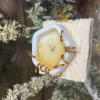i found 3 queens and they are all together laying eggs but they did not have their fungus pellets any one around san antonio with a colony i can get some starter fungus from?
- Formiculture.com
- Forums
- Gallery
- Members
- Member Map
- Chat

i found 3 queens and they are all together laying eggs but they did not have their fungus pellets any one around san antonio with a colony i can get some starter fungus from?
Keeping:
5x - S. molesta (founding) 2x - C. pennsylvanicus (colonies)
4x - C. chromaiodes (colonies)
4x - T. immigrans (founding queens and colonies)
1x - F. subsericea (founding)
Check out my C. nearcticus journal here: https://www.formicul...cticus-journal/
Check out my C. chromaiodes journal here: https://www.formicul...aiodes-journal/
One of the articles (from 2022) stated not very clearly though but not with too much doubt that they were created from trophic eggs. Perhaps a typo of some sort then.Atta do not make fungus pellets out of trophic eggs.
Edited by Artisan_Ants, May 14 2024 - 12:53 PM.
Keeping:
5x - S. molesta (founding) 2x - C. pennsylvanicus (colonies)
4x - C. chromaiodes (colonies)
4x - T. immigrans (founding queens and colonies)
1x - F. subsericea (founding)
Check out my C. nearcticus journal here: https://www.formicul...cticus-journal/
Check out my C. chromaiodes journal here: https://www.formicul...aiodes-journal/
One of the articles (from 2022) stated not very clearly though but not with too much doubt that they were created from trophic eggs. Perhaps a typo of some sort then.Atta do not make fungus pellets out of trophic eggs.
A source would be helpful. Fungus pellets =/= trophic eggs though, as fungus pellets are carried in the mouth by female alates prior to leaving the nest.
"Float like a butterfly sting like a bee, his eyes can't hit what the eyes can't see."
- Muhammad Ali
Check out my shop and Formica journal! Discord user is bmb1bee if you'd like to chat.
Also check out my YouTube channel: @bmb1bee
One of the articles (from 2022) stated not very clearly though but not with too much doubt that they were created from trophic eggs. Perhaps a typo of some sort then.Atta do not make fungus pellets out of trophic eggs.
0 members, 1 guests, 0 anonymous users